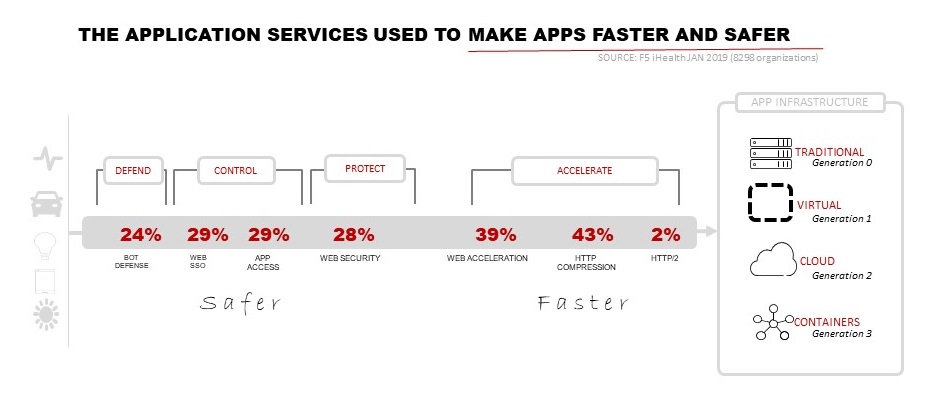Update der Application : Programmierbarkeit auf dem Vormarsch
Willkommen zurück! Die interessante Entwicklung bei den Application in diesem Quartal betraf alles Programmierbare. Vom Datenpfad (iRules) bis hin zum Application (Rewrite) und der Sichtbarkeit (x-forward-for) hat die Nutzung der Programmierbarkeit von Quartal zu Quartal zugenommen.
Während der Schwerpunkt bei der Programmierbarkeit heute hauptsächlich auf dem Betrieb liegt, bleibt ein erheblicher Teil der Datenpfad Programmierbarkeit bestehen, die für die Interaktion der Verbraucher mit Applications von entscheidender Bedeutung ist. Insgesamt stieg die Datenpfad über iRules bis zum Ende des Quartals um 2 %, wobei 83 % der Organisationen die Möglichkeiten dieser Funktion nutzten. Organisationen verwenden iRules, um Prozesse anzupassen und zu kodifizieren, die den Datenverkehr vom Client zur Application regeln. Da Sie mit iRules Anfragen und Antworten in Echtzeit abfangen und darauf reagieren können, sind die potenziellen Anwendungsfälle so vielfältig wie die Applications und Arbeitsabläufe, die sie unterstützen.
Die größte Veränderung (+3 %) betraf die allseits beliebte (und notwendige) X-Forwarded-For-Funktion, die die Sichtbarkeit der Client-IP-Adressen für die Applications ermöglicht, die diese benötigen. Zunehmend wurde auch die Verwendung von Umschreibefunktionen genutzt, die es Betreibern ermöglichen, eingehende URIs transparent internen URIs zuzuordnen. Diese Funktion wird häufig verwendet, um Versionen von APIs oder Websites zu migrieren oder eine API-Fassade aufzubauen, ohne dass zusätzliche Infrastruktur erforderlich ist.

VERTEIDIGEN |
KONTROLLE & SCHUTZ |
STANDORT |
|---|---|---|
VERTEIDIGUNGSMASSNAHMEN WACHSEN |
SICHERHEIT ERHÖHT |
LEISTUNGSSTEIGERUNGEN |
Wenig überraschend stiegen die Bot-Abwehrdienste im Vergleich zum letzten Quartal um 2 % und erreichten damit fast ein Viertel (24 %) der Organisationen. Auch bei anderen defensiven Application gab es leichte Zuwächse, insbesondere im Web-Sicherheit , wo ein Anstieg von 1 % zu verzeichnen war. Untersuchungen von F5 Labs haben ergeben, dass die Hälfte des gesamten Internetverkehrs von Bots stammt. Fast ein Drittel (30 %) davon sind böswillig. |
Auch die Sicherheitsdienste konnten im Vergleich zum Vorquartal leichte Zuwächse verzeichnen: Die Einzelanmeldung (Single Sign-On) stieg von 28 % auf 29 % der Organisationen, und auch der Application konnte mit diesen Zuwächsen Schritt halten. Angesichts der Tatsache, dass die Mehrheit der Teilnehmer unserer Umfrage „State of Application Services 2019“ keine Application ohne Sicherheit bereitstellen würde, sind wir von den langsamen, aber stetigen Zuwächsen bei sicherheitsrelevanten Application nicht überrascht. |
In einem seit mehreren Jahren wiederkehrenden Muster hat die Leistung die Verluste aus den vorherigen Quartalen wieder wettgemacht, wobei Caching, Webbeschleunigung und TCP-Multiplexing im Vergleich zum Vorquartal jeweils um 2 % zulegten. HTTP/2 wird nach wie vor nur von trägen 2 % der Organisationen genutzt und angesichts der bevorstehenden Neuigkeiten zu HTTP/3 erwarten wir, dass dieser Trend weiter anhält, bis die neueste Version von HTTP ratifiziert und allgemein verfügbar ist. |
Weitere Informationen zu Application finden Sie in unserem Bericht „State of Application Services 2019“ und im nächsten Quartal auf die nächste Ausgabe unseres Application Services Update.
